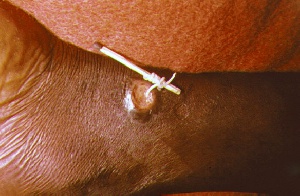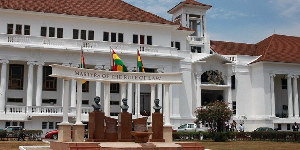Introduction
Over the years, many scholars in Health Economics have argued that, the prevalence of many communicable diseases in developing countries accounts for the slow pace of economic development. It is for this reason that, there is great joy in celebrating global efforts to eradicate the Guinea worm disease worldwide. Of particular importance to this study is, the efforts that have been made in the developing world. The Carter Center and the World Health Organization (2019), have indicated that, " national ministries of health have reduced annual incidence of Guinea worm disease by 99.99 percent from an estimated 3.5 million human cases in 1986 to 28 human cases in 2018. To date, WHO has certified 187 member states as free of transmission of the disease, including 16 that were formerly endemic".
Dracunculiasis (that is, Guinea worm disease) is a parasitic infection acquired by drinking water from ponds contaminated by copepods (water fleas) that contain immature forms of the parasite. A year after initial infection, a 30-inch (1 meter) worm(s) emerges through the skin, usually on the lower leg. Each infection lasts approximately 1 year MMWR (2001) and re-infection is always a possibility if care is not taken to prevent its occurrence. The disease has the tendency to make those affected very weak, experience pain, incapable of carrying out any productive economic activity, bed ridden and has the tendency to disfigure one’s leg. The main countries in the developing world that are currently prone to this disease are Chad, Ethiopia and Mali. Sudan and Ghana were formerly endemic, but have made great efforts to curtail the spread of the disease.
The purpose of this study, however, is to critically examine how Ghana and Sudan were able to make progress in their
Guinea worm eradication efforts and what challenges arose in the process and the way forward.
In order to get a full picture and a clear understanding of the Guinea Worm problem in these two countries, I first explore the country profile and health indicators of Ghana and Sudan. Then, I examine the important question of why the eradication of Guinea Worm was necessary and its impact on health. This is followed by a critical discussion of the approaches or interventions in dealing with Guinea Worm Eradication in Ghana and Sudan, which culminated in the successes that has been chalked, gaps and barriers and conclusion of the study.
Background:
Country Overview:
Ghana is an Anglophone country situated in West Africa with a population of about 28.207 million people (WHO 2019). With a total area of 238,533 square kilometers, Ghana is about the size of Britain. Ghana is a country endowed with a lot of natural resources and was the first country in Sub-Saharan Africa to gain Independence in 1957.
However, due to poor management and planning, rampant coup d’etats, corruption, excessive government expenditure and falling prices of major export commodities (cocoa, gold, timber and bauxite) on the world market and the wholesome adoption of structural adjustment policies in the 1980s and 1990s, Ghana was plunged into serious debt problems resulting in poor development of key sectors of the economy.
That said, over the years, Ghana has made great strides in its economic indicators and is now termed a middle income country. With the discovery of oil, a more robust economy and a stable political climate; Ghana has experienced some amount of consistency in development planning, resource allocation and efficient management of the economy. This has given rise to better expenditures on health care. For example, in 2014, total health expenditure as a percentage of the GDP was 3.56 compared to 2.83 in 2001.
On the other hand, Sudan is located in northeastern Africa. It is the largest country in Africa with a total population of 36,233,000. Petroleum is Sudan’s major natural resource. The country also has small deposits of chromium ore, copper, gold, iron ore, mica, silver, tungsten, and zinc.
Further, Sudan is a nomadic cattle rearing region. However, civil war in 1983 and the devastating droughts of the 1980s and early 1990s decimated not only the Nilotic herds but livestock throughout Sudan. The war led to hunger, fear, displacement, deaths, and break- down in infrastructure and health facilities. Although the war has ended, the country is now divided into Southern and Northern Sudan; the effects of the civil war still remains and had hindered initial progress in Guinea worm eradication (http://workmall.com/wfb2001/sudan/sudan_economy.html).That said, Sudan has made progress over the years in its efforts to stop the spread of Guinea worm disease and is now proclaimed by the WHO as free of the disease.
Burden of disease: Ghana and Sudan:
The World Health Report (2006) indicates that, life expectancy in Ghana for males and females at birth stood at 56.0 and 58.0 years respectively in 2006. In 2019, WHO states that,
life expectancy in Ghana for males was 62.5 and females 64.4.
This indicates, an improvement in health care.
In Ghana, Infant Mortality rate in 2004 was 68 births per 1000 live births while the maternal mortality rate in 2000 was 540 births per 100,000 live births. In 2018, Ghana's under 5 mortality rate was 47.9, and maternal mortality ratio in the same year was 308 per 100,000 live births. This shows a fall in death rates and a plausible improvement in health.
Further, in Ghana among the adult population, the five major causes of death are HIV/AIDs/TB, Non communicable diseases (cancer, cardiovascular disease, etc), Malaria, Diarrhorea, Hepatitis and Typhoid fever and our current Coronavirus; while death among children in Ghana can be attributed to neonatal causes such as Malaria, Pneumonia, Diarrhorea and HIV/AIDs (WHO 2008).
On the other hand, the World Health Report (2006) points out that, life expectancy in Sudan for males and females at birth was 56.0 and 60.0 years respectively. In 2016 life expectancy for males was 63 and 67 for females. This shows an improvement in life expectancy - meaning on the average, adult Sudanese are living longer.
In 2006, the World Health Report indicates that,
Child mortality for males in Sudan was 98 per 1000 births and that of females was 84 per 1000 births. Similar to the Child mortality rates, in 2006, Sudan shows a worse Adult mortality rate for men which stood at 390 per thousand and women 304 per thousand. The top five causes of death among adult populations in Sudan was HIV/AIDs/Tuberculosis, non- communicable diseases such as, Malaria, Trypanosomiasis (African sleeping sickness), Meningococcal Meningitis and Diarrhorea (WHO 2008). Children suffer mostly from neo-natal causes, Malaria, Pneumonia, Diarrhorea and HIV/AIDs. But there appears to be some improvement. For example, in 2018, WHO, reports that, the under 5 mortality rate per 1000 births was 60 (WHO 2018). This is great improvement over the years.
Nevertheless, the implication of the data for adult populations in Ghana and Sudan indicates that, adults on the average do not live beyond their 60th birthday in the early 2000s. But in 2016, there was great improvement as the adult age stood at 67 years for females and 63 years for males in Sudan while in Ghana it was 64.4 years for females and
62.5 years for males. Yet, this is nowhere near adult populations of advance countries like Japan where many adults live beyond their 75 birthdays and are healthy and can engage in some viable form of economic activity (WHO 2019).
Average Income: Ghana and Sudan
UNICEF statistics show that, Ghana’s Gross National Income (GNI) per capita in 2005 was US$ 450 while in 2018, The World Bank estimates Ghana's GNI per capita at $ 4650. For Sudan, the UNICEF statistics show that GNI per capita was US$ 640. (://www.unicef.org/infobycountry). In 2018, Sudan's Gross National Income per capita was $ 4420 as reported by the World Bank.
The implication of this situation in Ghana and Sudan is that, income levels have risen and the relative levels of poverty have fallen. With increased incomes, savings and investments are also bound to rise. Majority of the population will now earn an appreciable level of income that will take care of their basic needs and help curtail every day survival strategies and struggles and improvements in the quality of food and drinking water which will help avoid rivers and streams infested with Guinea worm larvaes.
Adult literacy:
The World Health Report (2006) reveals interesting statistics on the adult literacy rates in Ghana and Sudan. According to the report the adult literacy rate for Ghana in 2004 was 54% while in the same year Sudan’s Adult literacy rate was 59%. This is interesting because in spite of the war, and the drought situation in Southern Sudan and parts of the country, Sudan did better than Ghana, on educating its adult population. In 2019, however, the World Bank estimates that, the adult literacy rate in Sudan was 56.06 while that of Ghana's was 67. This shows that, Ghana has made great strides in improving adult literacy rate in comparison to Sudan.
Nevertheless, these figures are low if higher levels of development are to take place in both countries.
Health System Indicators: Ghana and Sudan.
The World Health Report (2006) points out that, Ghana‘s total expenditure on health as a percentage of the Gross Domestic Product was 4.5% in 2003. Private expenditure on health as percentage of total expenditure on health was 68.2% in 2003. In 2004 the number of Physicians in Ghana was 3, 240 with a density 0.15 per a 1000 of the population.
Similar to Ghana, Sudan’s total expenditure on health as a percentage of Gross Domestic Product (GDP) was 4.3% in 2003. Private expenditure on health as percentage of total health expenditure was 56.8%. Sudan had 7,552 Physicians in 2004 with a density of 0.22 per a 1000 of the population (World Health Report (2006).
That said, according to WHO, in 2014, total government expenditure on health as a percentage of GDP in Sudan was 8.43. Private expenditure on health as a percentage of total expenditure in 2014 was, 78.26 in Sudan. Also in Sudan, the Physician density per 1000 of the population was 0.314 in 2010. While in Ghana in 2014 according to WHO, total expenditure on health as a percentage of GDP was 3.56. Private expenditure on health as a percentage of total health expenditure was 40.15. And physician density per a 1000 of the population was 0.096 in 2010. And according to the UK Home Office (2019) the number of doctors in Ghana in 2016 was 3365.
This shows that, in both countries health expenditure as a percentage of GDP has increased. The density of doctors to the population was rising in both countries. Although it appears, Sudan did better than Ghana in terms of doctors to the total population. It is plausible to argue that, Sudanese doctors are staying home in comparison to their Ghanaian counterparts and perhaps enjoying the modest gains and growth in the Sudanese economy.
Guinea Worm Eradication ( Dracunculiasis) in Ghana and Sudan and the rest of the World.
From the table in the appendix below, in 2005, there were 10, 629 reported cases of Guinea worm worldwide. Sudan and Ghana constituted about 95% of the cases - that is, 5569 ( Sudan) and 3977 ( Ghana) with the lowest cases of 9 in La Cote D' Ivoire. In 2006, Sudan's cases short up to 20, 580. This could be attributed to the drought and civil war which prevented surveillance, campaigns and other measures necessary to control the spread of the disease. On the other hand in 2006, Ghana recorded 4,134 cases. But interestly, by May 2007, the situation had changed dramatically between the two countries. Sudan in 2007 had 1609 reported cases while Ghana had 2904 cases. This indicates that, between 2005 and 2007, the fortunes of Sudan in terms of handling the disease had improved considerably compared to Ghana. This improvement could have been attributed to the end of hostilities and the Sudanese people seeking more medical attention to curb the spread of the disease, while in Ghana, the slow pace of progress could have been attributed to a little slack in campaigning efforts and perhaps the lack of enthusiasm by local people to continue aggressively the educational process, the wane in publicity, poor surveillance and political will. That said, the numbers in Ghana in 2007 were 2904 cases almost a 1000 cases below the figure in 2005. This shows progress but at a slow pace when compared to the Sudanese figures which represent 77% drop in Guinea worm cases from 2005.
According to the Morbidity and Mortality Report Weekly Report (MMWR) of the Centre for Disease Control (2005) in 1986, an estimated 3.5 million cases of Guinea Worm occurred in 20 countries, and 120 million persons were at risk for the disease. That year, the World Health Assembly adopted a resolution calling for the eradication of Dracunculiasis, (Guinea worm disease). Reports from the global eradication program indicated that by July 2005, a total of 8,191 indigenous cases of Guinea Worm were reported from nine countries, with at least 150 million persons at risk. Despite the substantial reductions in Dracunculiasis cases since 1986, eradication of Dracunculiasis will require international commitment and ongoing surveillance and intensified interventions at national, state, and local levels.
Why is the eradication of Guinea Worm Important
Greenaway (2004) argues that, Dracunculiasis (Guinea Worm Disease) is a parasitic disease that is limited to remote, rural villages in 13 sub-Saharan African countries that do not have access to safe drinking water. It has been one of the diseases targeted for eradication by the World Health Organization. Guinea worm disease is transmitted by drinking water containing copepods (water fleas) that are infected with Dracunculiasis medinensis larvae. One year after human ingestion of infected water, a female adult worm emerges, typically from a lower extremity, producing painful ulcers that can impair mobility for up to several weeks. This disease occurs annually when agricultural activities are at their peak. Large proportions of economically productive individuals of a village are usually affected simultaneously, resulting in a decreased in agricultural productivity and economic hardship. Thus, in countries like Ghana and Sudan where the disease was endemic there was the need for serious action by both government and private sector to eradicate the disease and make those affected strong and ready to contribute their quota to the development process (Cairncross et al 2002). This was also critical to prevent low food crop production and cash crops urgently needed for exports to earn foreign exchange to buy farm implements like tractors and combine harvesters and highly improved seeds that can boost production and additional capital for investments and hiring and maintaining labour on the farms.
What would be the potential disease impact on health?
Greenaway (2004) stresses that; more than 90% of worms emerge from the lower extremities, usually below the knees. Infected people in Ghana and Sudan commonly had multipleworms emerging at the same time (1.8 per person on average), with as many as 14 reported in one individual. In Ghana and Sudan secondary infection of ulcers occurs in most cases, because the rural populations had little or inadequate access to proper medical care. In addition to local cellulitis, wound complications may lead to abscess formation, tetanus, septic arthritis or systemic sepsis. Infection of joints may subsequently result in deformities or contractures. The prolonged incapacity per episode of guinea worm disease was due to the emergence of worms from weight-bearing parts of the body and high rates of secondary infection. Sometimes continuing pain for 12–18 months was experienced after the emergence of the worms (Kim et al 1997).
Efforts from the Canadian government, Institutions and International NGOs :
The Canadian International Development Agency (CIDA) CDPF/PRSP/ Health for Ghana and Sudan played a critical role in helping the two countries overcome their challenges in curtailing the spread of Guinea Worm disease.
The Bill & Melinda Gates Foundation pledged US$25 million to the Carter Center’s fight to eradicate the remaining cases of Guinea worm disease worldwide. The grant included an initial $5 million contribution and challenged other donors to provide an additional $20 million, of which the Gates Foundation would match each dollar raised. At the time, CIDA and the Conrad N. Hilton Foundation had responded to the challenge by pledging $5 million and $1 million, respectively, joining with the Carter Center and the Gates Foundation to help make Guinea worm the first parasitic disease to be eradicated worldwide. (http://www.cartercenter.org/news/documents/doc2054.html).
According to Former US President Jimmy Carter, support from the Gates Foundation, CIDA, and the Conrad N. Hilton Foundation demonstrated international leadership in the fight against unnecessary suffering in the developing world. It was a historic moment as the world worked together, in all communities around the globe to eradicate this 3,000-year-old disease.
CIDA, and the Conrad N. Hilton Foundation together pledged US $6 million for the Guinea Worm Eradication Project (Phase II from 2005-2009). The project provided financial assistance to help national eradication programs to make their surveillance systems and case containment strategy more effective and (former) endemic countries like Ghana and Sudan, to maintain national awareness, refocusing and giving priority to health education and community mobilization. Further, the project combined various strategies to ensure access to clean drinking water to remote villages and displaced people. However, the long-standing conflict between the North and the South of Sudan had initially hindered progress but with the signing of the Comprehensive Peace Agreement (CPA) to end the war in January 2005, conditions became favorable to facilitate and enhance eradication efforts. Shortly afterwards, at the Oslo Donors’ Conference on Sudan in April 2005, Canada again committed $90 million over two years to support the successful implementation of the CPA: $40 million in development resources to multi-donor trust funds; $40 million in continued humanitarian assistance; and $10 million to support bilateral reconstruction and rehabilitation programs (http://www.acdi-cida.gc.ca/sudan).
Approaches or Interventions in dealing with Guinea Worm Eradication in Ghana and Sudan:
Ghana and Sudan received technical and financial support from a global coalition of organizations led by the Carter Center, the United Nations Children’s Fund, the US Centre for Disease Control and Prevention, and the World Health Organization. These two countries, among other countries had implemented national Guinea Worm Eradication Programs, run through the ministries of health. The primary interventions of the campaign included:
i. The provision of safe water (through deep well digging, applying larvicide and purifying water through cloth filters);
ii. Health Education (Ruebush1998).
iii. Case containment, management and surveillance were ways to reduce the spread of the disease (Centre for Global Development 2005; Millions Saved Case 11). For example, in Ghana between 2004 and 2005 the Nkwanta District was one of the most endemic areas of the country. But with great containment efforts, intervention measures and careful supervision of infected persons by staff of the eradication program, this district saw reductions in infection rates. Also, adequate surveillance of previous endemic regions was critical in preventing the reintroduction of the disease in those areas (MMWR 2005).
In Sudan, cases exported from southern states to the northern states and neighboring countries indicated a decline. The reductions in cases within southern Sudan were a net result of underreporting, inaccessibility to disease-endemic areas during the civil conflicts, access to newly secured areas, and the effects of interventions by Sudan’s Guinea Worm Eradication Program.
What are the gaps in addressing Guinea Worm Eradication in Ghana and Sudan?
There were some gaps in eradicating Guinea Worm disease in Ghana and Sudan. Rural knowledge base was weak. It appeared that, the rural people in worse affected villages in both countries belief the disease to be caused by witch craft and not by tiny fleas called copepods carrying the Guinea worm larvae. Thus, rural people continued to use water sources that were contaminated by fleas (Watts 1998).
The governments of Ghana and Sudan seem to indicate that, there was the need to eradicate the Guinea worm disease yet, health expenditure as a percentage of GDP was small in comparison to government expenditure on the other sectors of the economy. This situation was not typical to Ghana and Sudan but a large number of African countries were guilty in this regard. Instead of championing health education and eradication campaigns, African governments would rather want to leave these educational processes to NGOs and to the international community.
There was also the lack of strong will and commitment by both governments and the people to fight against the Guinea worm disease. In Sudan the conflict among the people in the north and south prevented any formidable work to be done. While in Ghana, conflicts in the northern region, one of the most endemic areas of the country hindered progress.
What are the barriers in addressing Guinea Worm Eradication in Ghana and Sudan?
i. In Ghana, Guinea worm eradication was difficult, as those who were infected did not report their cases and were not ready for treatment. Similarly, in Sudan, people were afraid to come out to report their cases for treatment due to the fear of being caught up in the civil war. Yet, one could argue that, treatment promoted the disruption of the worm’s transmission for a year. This was possible through three principal interventions, that is, (a) the construction of safe water sources, (b) vector control through the use of larvicides in water sources and (c) health education to promote behavioral changes and the filtration of water with cloth filters.
ii. In Ghana and Sudan sanitation problems aided by the recontamination of public water sources hindered eradication efforts. This situation was more acute in Sudan as part of the country is a desert and dry and there were only a few oases supplying clean and portable water all year round.
iii. The lack of accurate data on disease prevalence and the inability to access very remote villages in Ghana and Sudan impeded progress in the eradication efforts (Ruebush1998).
iv. Ghana and Sudan are relatively poor to middle income countries who do not have adequate financial resources. Yet, the construction and the maintenance of safe water sources was time consuming and required resource intensive processes involving considerable external financing which could disrupt the Guinea worm eradication campaign and efforts (Kim et al 1997).
What were the potential opportunities for addressing Guinea Worm Eradication in both countries?
(i) In Ghana, officials of the Guinea worm eradication program recruited journalists in a campaign against the disease. The Carter Center had sponsored workshops for journalists as part of an effort to help educate the public about the disease. While in Sudan, some progress had been made in the northern part of the country due to ongoing education and 90% of the villages had at least one safe source of drinking water (MMWR 2001).
(ii) Negotiations were concluded between various community leaders and groups in worse infected areas of both countries. For example, in northern Ghana, negotiations were reached between community leaders to allow easy access of people to treatment centers. This prevented volunteers and program implementers from being drawn into any local conflicts. Similarly, in Sudan, the Carter Foundation had negotiated a peace truce which helped reduced the risk in traveling to areas where the war had been intense.
(ii) In both Ghana and Sudan accurate data on the disease was needed to help tackle the disease head on. Further, serious political commitment was needed in galvanizing support, resources and focusing attention on the disease (Maguire 2002).
(iii) In addition, the Ghanaian Ministry of Health had launched a stepped-up marketing and awareness campaign including billboards, radio slots, public service announcements, TV documentaries and community activities to educate the public on the dangers of the Guinea Worm disease. Seven Districts in the northern region of Ghana benefited from the nine million-Euro project. This, provided funds for community water sanitation projects, community education, vehicles, and motorcycles, to improve field transportation, training and motivation of volunteers (Ghana News Agency 2007). And indeed, this was a laudable effort, as it was hoped that, Sudan could do same when the peace situation was more certain.
(iv) There is no vaccine or immunity to the disease, but it could be kept from spreading in Ghana and Sudan by using simple filtering techniques, preventing infected persons from re- entering water sources. This was very successful in Ghana and Sundan and helped curtail the spread of the Guinea worm disease (WHO/UNICEF 2004).
(v) Boreholes were constructed for small villages and nomadic populations in northern Ghana which cost over $10,000.00. This was expensive if many more of these affected populations were to be reached. Thus, quality and cost-effective boreholes were needed for other communities to benefit from the program (Mattelet 2006).
Conclusion
Eradication efforts have led to a 99.7 percent drop in Guinea worm prevalence worldwide. In 2005, fewer than 11,000 cases were reported, compared with an estimated 3.5 million infected people in 1986. By 1998, the campaign prevented between 9 million and 13 million cases of Guinea worm. As of 2005, the campaign had prevented more than 63 million cases of Guinea worm disease, reduced the number of endemic villages by 91 percent, and stopped the transmission of the disease in 11 of the 20 endemic countries (Centre for Global Development 2005; Millions Saved Case 11). As of 2018, there were only 3 endemic nations - Chad, Ethiopia and Mali and 28 human cases.
The total cost of the program between 1986 and 1998 was $87.4 million. The estimated cost per case was $5 to $8. The World Bank determined that, the Guinea Worm Eradication campaign was highly cost-effective and cost-beneficial. The economic rate of return based on agricultural productivity alone was estimated at 29 percent. The estimated cumulative cost of the campaign as of 2004 was approximately $125 million (Centre for Global Development 2005; Millions Saved Case 11).
Therefore, it is possible to argue that, the success that was chalked in Guinea worm eradication in the endemic countries like Ghana and Sudan was due to the increased attention and efforts of governments of these two countries and the redirecting of more resources to the health sector. This was also possible, through focused planning, careful financial management and judicious use of resources to achieve positive outcomes and critically, the sustained commitment of International donors and partners to this wonderful project.
References
1.Cairncross, S., Muller, R. and Zagaria N. (2002) Dracunculiasis Guinea worm disease and the Eradication Initiative. Clinical Microbiology Review.;15 (2):223–246.
2. CIA World Fact book (2001) Sudan Economy 2001.
Available at http://workmall.com/wfb2001/sudan/sudan_economy.html
3. Geography of Sudan (2007). Available at http://en.wikipedia.org/wiki/Geography_of_Sudan
4. Ghana Health Service (2001) Roll Back Malaria Baseline Survey 2001. Accra , Ghana
5. Ghana News Agency (2007) Carter expresses concern about Ghana's progress on Guinea worm eradication
http://www.ghanaweb.com/GhanaHomePage/NewsArchive/artikel.php?ID=118778
6. Greenaway, C (2004) Dracunculiasis (Guinea Worm Disease). CMAJ. 2004 Feb 17. 170(4): 495-500. Review.
7. Guinea Worm Eradication project (Phase II) available at
http://www.acdi-cida.gc.ca/CIDAWEB/cpo.nsf/vWebProjByNumEn/58FA883B4EFEBBA38525710F0036FE93
8. Kim A, Tandon A, Ruiz-Tiben E.(1997) Cost-Benefit Analysis of the Global Dracunculiasis Eradication Campaign. Policy Research Working Paper 1835. Washington , DC : World Bank, Africa Human Development Department;
9. Morbidity and Mortality Weekly Report (2001) Progress Toward Poliomyelitis and Dracunculiasis Eradication - Sudan , 1999-2000: Centers for Disease Control and Prevention, Atlanta , U.S.A
10. Morbidity and Mortality Weekly Report (2001) Progress Toward Global Eradication of Dracunculiasis, January 2004-July 2005: Centers for Disease Control and Prevention, Atlanta , U.S.A
11. Maguire. J,H, (2002). Dracunculiasis Eradication: and now, Sudan: Am J Tropical Medical Hygiene.; 67(4):415–422.
12. Mattelet, Claire (2006). “Household Ceramic Water Filter Evaluation Using Three Simple Low-Cost Methods: Membrane Filtration, 3M Petrifilm and Hydrogen Sulfide Bacteria in the Northern Region of Ghana ” Master of Engineering Thesis, Massachusetts Institute of Technology. Cambridge , MA . May 2006
13. Ruebush, K. T. (1998) Detect Every Case, Contain Every Worm: Needed: Better Supervision of Village-Based Health. WHO CollaboratingCenter for Research, Training, and Eradication of Dracunculiasis, NCID, Centers forDisease Control, Atlanta , GA USA .
14. Sudan : Canada ’s Commitment, Canadian International Development Agency. Available at http://www.acdi-cida.gc.ca/sudan
15. The Carter Foundation (2005) Guinea Worm Eradication Program Gets $25 Million Challenge Grant From Gates Foundation. Available at http://www.cartercenter.org/news/documents/doc2054.html
16. The Carter Center and WHO (2019) " Eradication of Guinea Worm Disease, Case Statement", Carter Center, Atlanta Georgia USA and WHO , Geneva Switzerland.
17. UK Home Office (2019) " Country Policy and Information Notes: Ghana, Medical and Healthcare Issues, Version 1.0, UK.
18. UNICEF (2005) Country Statistics. Available at http://www.unicef.org/infobycountry/
19. Watts S, (1998) Perceptions and Priorities in Disease Eradication: Dracunculiasis Eadication in Africa . Soc. Sci. Med, 46:799-810
20. World Health Report (2006) Working Together for Health. World Health Organization, Geneva Switzerland .
21. WHO Press Release (2000) WHO Issues New Healthy Life Expectancy Rankings: Japan Number One in New Health Life System. Washington , DC and Geneva , Switzerland .
22. WHO/UNICEF (2004) Meeting the MDG Drinking, Water and Sanitation Target: A Mid-Term Assessment of Progress. Joint Monitoring Programme for Water Supply and Sanitation. USA , Geneva Switzerland .
23. World Health Organization (2001) The world health report 2001 - Mental Health: New Understanding, New Hope, Geneva, Switzerland.
24. World Health Organization (2008) "The World Health Report 2008 - primary Health Care (Now More Than Ever)", Geneva Switzerland.
25. World Health Organization (2010) World Health Statistics 2010, Geneva, Switzerland.
26. World Health Organization ( 2014) World Health Statistics 2014, Annual Report, Geneva Switzerland.
27. World Health Organization ( 2016) World Health Statistics 2016: Monitoring health for the SDGs. Geneva Switzerland.
28. World Health Organization (2018) World Health Statistics 2018: Monitoring health for the SDGs, Geneva, Switzerland.
29. World Health Organization ( 2019) World Health Statistics 2019: Monitoring health for the SDGs. Geneva Switzerland.
30. World Bank (2014) Development Indicators, Washington DC, USA.
31. World Bank (2019) Development Indicators : Changing the Nature of Work, Washington DC, USA.
32. World Bank (2018)
The World Development Report 2018 "Learning to Realize Education's Promise", Washington DC, USA.
Appendix
Opinions of Tuesday, 15 September 2020
Columnist: Kordson Ayrakwa















